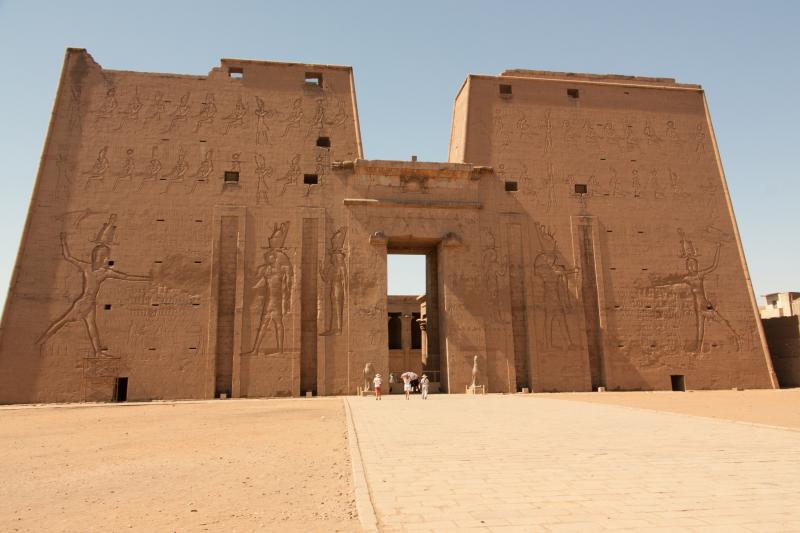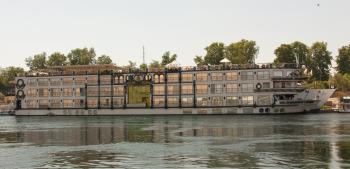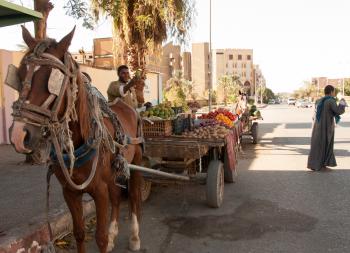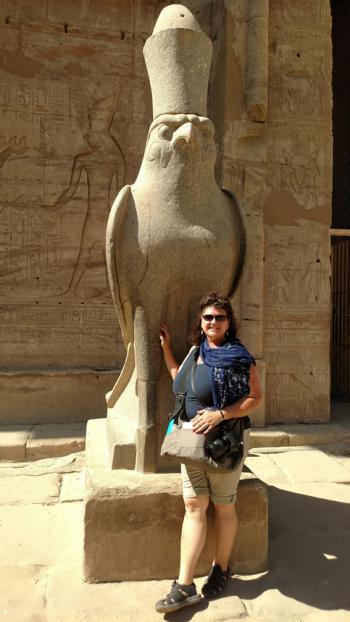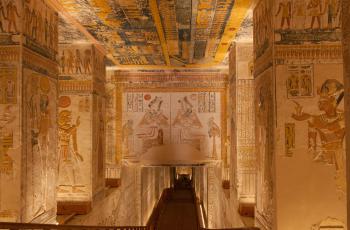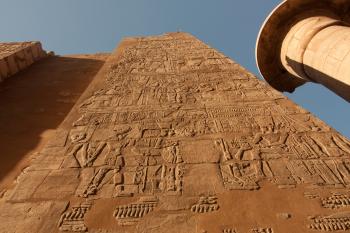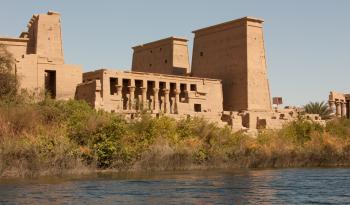Cruising the Nile on a customized tour of Egypt’s magnificent sites
This article appears on page 6 of the December 2018 issue.
Following a 2018 overland tour with Amazing Global Travel to see the ancient sites in and around Cairo (Nov. '18, pg. 6), Debi's journey continues with a cruise along the Nile.
I arrived in Aswan from Cairo early in the morning, and, once I was checked into my cabin aboard the Sonesta St. George 1, I departed with my new guide, Mahmoud Aly, on a felucca ride to the Aswan Botanical Garden, located on a small island off the eastern bank of the Nile.
Originally inhabited by Lord Kitchener in 1898, when he was commander of the Egyptian army, this nearly 17-acre island was turned into a massive garden with plants and trees from all over the world, including 25 different varieties of palms. Today, it is a popular local picnic spot, and there were several families enjoying the gardens when I visited.
After lunch back on board the ship, Mahmoud and I ventured out again, this time to visit the Aswan High Dam and Philae Temple.
Construction of the first dam at Aswan began in 1899 in an effort to prevent the Nile's annual floodwaters from destroying crops planted in its fertile valley. When the first dam failed and attempts to raise it were unsuccessful, it was decided that a second dam would be built farther upriver. That construction began in 1960 and took 10 years to complete.
Today, it is a source of hydroelectric power and Egyptian pride.
The construction of the first dam caused Philae Island, which was home to a temple complex, to flood periodically. In 1960, UNESCO stepped in and led the laborious process of moving the temple complex, piece by piece, to nearby Agilkia Island, where it was painstakingly reconstructed.
We accessed the island by boat and spent a good hour viewing the temple ruins as Mahmoud explained the meaning of each of the carvings to me. A line of enormous columns topped with patterns of lotus and papyrus led to temples dedicated to Isis, Osiris, Horus and Hadrian, each decorated with detailed carvings of pharaohs and deities.
We returned to the ship by late afternoon, giving me time for a much-needed nap before dinner on board.
The ship
The Sonesta St. George 1 had 57 passenger cabins and five decks, with the main dining room on the lowest deck, at water level, and a pool and lounge chairs on the open-air top deck, from which passengers could enjoy the passing views.
My cabin, a spacious presidential suite on the fourth deck — to which I was upgraded due to the number of vacant cabins on this sailing — featured a comfortable king-sized bed, a roomy sitting area, a dressing table, more than adequate closet space and an ample spa-like bathroom.
The huge, floor-to-ceiling glass doors opened up to a French balcony (i.e., no veranda) and an unobstructed view of the Nile.
The ship's daily buffet breakfast included eggs to order, fresh fruit and juices, a cereal bar, cheese and pastries. Lunch and dinner were à la carte menu selections, with a choice of fish, chicken or beef for the entrée, each served with soup, bread and a decadent dessert.
During our sail to Edfu, I took advantage of the onboard spa and pampered my weary feet with a 30-minute reflexology massage ($25).
During most of our cruising segments, I sat on the top deck and watched the landscape change from desolate desert and sandstone cliffs to flourishing, vibrant-green plantations of date palms, bananas, mangoes, figs, corn, sugarcane, henna and alfalfa.
I saw fishermen out on their modest vessels casting nets, villagers doing laundry, farmers tending their crops or cattle, feluccas traversing the waters and the occasional kid eagerly waving as we passed by.
Twin temple
We remained overnight in Aswan and set sail early the following morning to Kom Ombo, where we visited the dual temple of Sobek, the crocodile god, and Horus, the falcon-headed god.
From where we docked, it was a short walk to the steps that led to the temple's entrance. Once I reached the top and the temple came into view, I found myself awed by its majestic size.
It is believed that this temple was built during the Ptolemaic period, with several of the Ptolemy rulers adding to the site over time. There is also evidence of later construction by Augustus (around 30 BC) during the Roman period, but little of that remains.
Subsequent occupiers defaced many of the reliefs, and eventually the temple was plundered for building materials. Today, it sits in an advanced state of ruin, though efforts to halt its further decay were ongoing during my visit.
Nevertheless, it was still a site worthy of a visit. The double entrance of the temple leads to courts and colonnades, hypostyle halls and inner sanctuaries. Remnants of vibrant colors hint at the spectacle it must have been in its heyday.
Nearby was a small museum housing a collection of mummified crocodiles that had been found at the temple. Ranging from full-sized adults to embryonic eggs, these mummified remains were interesting, to say the least. And the visit provided a welcomed break from the heat.
Edfu
After returning to the ship, we set sail again, this time for Edfu. It was much too far for a casual walk, so we traveled from our dock to the Temple of Horus by horse carriage.
At first glance, I found the temple grounds unremarkable. I walked toward walls made of ancient as well as modern mud bricks, then turned a corner and walked through a narrow doorway that opened up to a grand courtyard, where the temple's towering, carved walls and entrance were astonishing.
This second-largest temple in Egypt, begun in 237 BC, took nearly 180 years to complete. Over time, the desert sands reclaimed the temple, and it remained hidden until the 1860s, when it was rediscovered by French archaeologist Auguste Mariette.
Dwarfed by the grand entrance, I walked into an open courtyard surrounded on three sides by columns. Across the courtyard stood a 10-foot-high granite statue of Horus. There were actually two statues, but the second no longer had its legs or crown and sat, less imposingly, on the ground.
I moved through to other halls and rooms, each dimly lit but filled with floor-to-ceiling carvings. Mahmoud pointed out hieroglyphs that represented perfume formulas that he said were still being translated by the French.
Of curious note were two rooms that seemed to be favored by bats. They somehow clung to the ceiling and weren't bothered by my presence as I slowly passed underneath.
On our return to the ship, Mahmoud stopped our carriage so we could enjoy a local beverage: fresh-squeezed sugarcane juice. It was a sweet, refreshing drink on a hot day.
Last stop, Luxor
Very early the following morning we departed Edfu for Luxor, or Thebes as it was known in ancient times. Because I had made independent arrangements that would immediately follow the cruise and cut my touring time short, the sites I visited on this day were doubled up.
On my agenda were the Colossi of Memnon, the mortuary complex of Queen Hatshepsut at Deir el-Bahri, an alabaster factory and the Valley of the Kings, plus the temples of Karnak and Luxor, which would usually be visited on a separate day.
On the 45-minute drive to the mortuary complex of Queen Hatshepsut, we made a brief roadside stop to view the Colossi of Memnon, two stone statues nearly 60 feet tall depicting a seated Amenhotep III.
In the distance, dug into the nearby mountain, I could see remnants of homes that had been removed to reveal ancient cave tombs. Over time, civilization had spread onto the mountainside, hiding potential treasures, and now UNESCO is spearheading the effort to uncover what may still remain.
Though it was still early in the day, the temperature was rising and there was little shade in sight. Reaching the temple complex of Hatshepsut, we took a shuttle train from the ticket office to the first level of the temple.
Hatshepsut was born to Thutmose I, and when he died, his son Thutmose II assumed the throne and married Hatshepsut, his half-sister. Upon his death, Thutmose III, his son by another wife, became pharaoh, but he was too young to rule, so Hatshepsut served as regent. In 1473 BC, Hatshepsut tired of her regent status and declared herself pharaoh, a title she held until 1458 BC.
Although the mortuary temple was started during the reign of her father, Hatshepsut finished the 3-level complex, nestled into the mountainside. Vibrant colors are still visible on some of the reliefs, and even stars painted on the ceiling along a colonnade remain, leaving me with the impression of how spectacular this must have looked in ancient times.
I made my way up to the third level to view the remaining statues of Hatshepsut, weathered but still standing after thousands of years.
Valley of the Kings
As we drove up the long, winding road to the Valley of the Kings, my tour began at the visitors' center, where a model of the valley with the location of each tomb was displayed. I watched a short video about Howard Carter's discovery of King Tut's tomb before heading out to the little train that took us to the entrance.
A general-entry ticket allows visitors access to three tombs; however, an extra ticket (EGP80, near $4.50) is required for each of the tombs of Ay, Tutankhamun, Seti I and the tomb of Ramses V and Ramses VI. Photography is now permitted in the tombs, but an additional ticket is required for that (EGP300). Keep your tickets on your person, as they are punched at the entrance to each tomb.
At the time of my visit, 13 tombs were open to the public; many had steep stairs, but some were wheelchair accessible. In all cases, handrails were available inside the tombs.
In an effort to conceal the royal tombs from grave robbers, the Egyptians chose to build them in this valley beneath the natural pyramid of a sacred mountain peak. A total of 64 tombs have been discovered there, and they are identified by number in the order in which they were found. (The most famous is KV62, the tomb of Tutankhamun.) KV64 was discovered in late 2012, and I was told that there are believed to be eight pharaohs' tombs yet to be located.
Personal guides were not allowed in the tombs, so Mahmoud would describe each tomb to me before I went in, and I tried to remember what he had told me to look for.
I chose to visit the tomb of Ramses IV (KV2) first, and as I descended the stairs and passed through the gateway entrance, I found myself transported thousands of years into the past.
Colorful hieroglyphs covered the walls from floor to ceiling, and the king's cartouche was carved in many places, identifying the body that should have lain within the gigantic stone sarcophagus. Life-sized depictions of the king's interactions with various deities, designed to help him transition to the afterlife, were also illustrated throughout the tomb.
I found similar features and artwork in the subsequent tombs I explored. Some were more elaborate than others, like KV9, the tomb of Ramses V and Ramses VI (begun for V but finished for VI).
The beautifully painted ceiling over the sarcophagus depicted the sky goddess Nut with the Book of the Day (as she daily gave birth to the sun) and with the Book of the Night (as she birthed the stars). The image was so grand in scale that I was unable to capture the full width of it in a single frame with my camera.
As magnificent as the tombs were, I found some of the tomb minders to be rude and aggressive, one yelling at me and demanding to see my photography ticket even after it had already been punched at the entrance. I reported this behavior to my guide and was told that the antiquities ministry takes such reports seriously.
Winding down
I returned to the ship for lunch before taking on the last two temples of my trip: Karnak and Luxor. The famed Karnak Temple, the largest ever built, did not disappoint.
At the visitors' center, a scale model of the temple complex displayed the current layout of the site, complete with a sacred lake, also the largest to be found near any of the temples. From the visitors' center, we walked across what was once part of the temple grounds and over a short and narrow (and steep) bridge that exited onto a wide passageway flanked by sphinxes that led to the current entrance.
Beyond its towering brick walls, a courtyard held smaller temple rooms, stand-alone pillars and a colossus of Ramses II. My gaze continued skyward as I tried to imagine the site in all its colorful glory.
The large hypostyle court, started by Ramses I, continued by Seti I and completed by his son, Ramses II, features 134 carved columns, the tallest of which are 72 feet high and 11 feet in diameter. That's a lot to take in!
This impressive, 200-acre complex was built over the span of 2,000 years, several kings adding to the original design.
With the light beginning to wane, we made our way over to the nearby temple at Luxor, believed to have been connected to the Karnak complex by the lengthy, sphinx-lined road.
Though started by Amenhotep III and added to by Tutankhamun, and Horemheb after him, this temple was completed by Ramses II, as evidenced by the many statues of him that remain. Five statues flank the imposing entrance, in addition to a single 82-foot-high, pink-granite obelisk. (Its match stands in Paris at the Place de la Concorde.)
The open courtyard leads to an open colonnade, passing the remains of a Coptic church and several more statues of Ramses.
The colonnade leads to another courtyard and, beyond that, a Christian basilica. There were once many more statues and temples within the complex, but time and rivalries have taken their toll. What remains is still an impressive site, however.
Outside the temple walls and along the sphinx road, current excavations have uncovered additional sphinxes. It seems Egypt still has her mysteries.
Closing thoughts
Being a guest in Egypt was a privilege. I found the people to be highly hospitable, and at no time did I ever feel unsafe or in danger.
Nile cruises are offered in both directions, but I think it's best to go from south to north, as I did, following the natural flow of the river; otherwise, you would see the grandest sites first, and the lesser sites at the end of the journey would not seem as impressive.
The air quality in Cairo was terrible and would not be ideal for those with breathing issues. Ever present in the air was a brown haze, which I could only assume was a combination of smog and shifting sands. Also, in Cairo it was disturbing to see the amount of trash along the canals, the streets and at historical sites, mainly from plastic bags and water bottles.
Public toilets rarely had paper, and if an attendant was present to offer some, I had to be prepared to tip with a couple of coins. Speaking of tipping, it was expected everywhere, especially at the tombs and temples. No one was graciously helping me by pointing out a secret passageway or offering to take my photo; a tip was always expected.
Souvenir hawkers were relentless, never taking a polite "No, thank you" for an answer. My guides, however, were protective and steered me to quality shops for requested purchases.
As my trip was in July, I felt the unrelenting heat of the day, punctuated only by the occasional breeze or the cover of shade. This was the price paid for traveling at low season; however, the tradeoff was fewer visitors at each site and being able to linger as long as I wished. I found a hat and a cooling cloth very useful. If you can stand the heat and keep yourself hydrated, it's worth it.
Amazing Global Travel (Chandler, AZ; 480/840-1947, www.amazingglobaltravel.com) can arrange similar Nile trips in either direction (cruising north or south), and each trip is entirely customizable. A trip similar to mine, with three nights in Cairo and a 4-night Nile cruise, starts at $2,000 per person (depending on cabin selected), not including international airfare.
The company really did an amazing job and took care of all the details. From airport transfers and hotel check-ins to providing cold bottled water each day, I truly wanted for nothing. Most meals and all site entrances, except for the extra photography fees, were also included.
My guides were extremely knowledgeable Egyptologists, each providing me with a crash course in Egypt's history, and they were very personable. I honestly felt as though I'd gained two new friends.
If you haven't yet been moved by history, give Egypt a try. You won't be disappointed!
Debi Shank was the guest of Amazing Global Travel.

